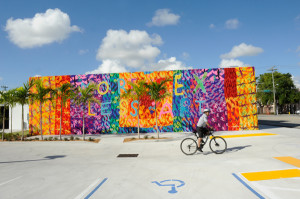Can ‘Art Basel Cities’ of the future find a future on the world culture map?
Two-dozen or so cities around the world are hell bent upon becoming great, says The Economist. They have identified good transport, green space and great culture as the basic minimum to achieve their goal. And Art Basel, the Swiss group that organizes art fairs, is pitching for a big role in the process. Apparently, the group says it will stage arty events in cities to help them build cultural capital. Those are its sentiments, if not its words exactly. It’s not clear what it will cost but perhaps that is a small matter in the larger goal of a city positioning itself as a cultural hub.
Can it work? Can a city manufacture a culture of artistic sensibility? Can the ‘Art Basel Cities’ of the future find a future on the international art map?
It depends on who you talk to.
Philip Levine, mayor of Miami Beach, says ‘yes’. Since Art Basel’s first Florida art fair 14 years ago, Mr Levine says Miami has 20 times more art galleries and many more public and private museums.
Perhaps. But sun-drenched Miami was, arguably, ripe to be a cultural destination. It is at the crossroads of three cultures – Central/South American, the Caribbean, Europe and North America. Equally crucially, artists were flocking to Miami for its low rents, wealthy collectors and the quality of light long before Art Basel decided to pick the city as a venue for its art fair.
Clearly, a city has to have a cultural DNA if it ever wants to become a cultural capital. Sometimes, too self-conscious an attempt to create an arts district can leave a city without the artists who would paint, sculpt or write and create its cultural scene.
Click here for a great piece by sociologist Meghan Ashlin Rich on Baltimore’s attempt to create a “naturally occurring” Arts & Entertainment District roughly around the same time that Art Basel came to Miami.
“There are clear ties between neighborhood revitalization strategies, public–private partnerships, and artist enclaves,” she writes. “…culturally led urban redevelopment policy maintains that what is good for artists is good for whole communities, and, in turn, will ‘lift all boats’, including impoverished residents, non-artists, and the city as a whole.”
But even though “urban revitalization strategies may aim to be more inclusive of diverse stakeholders’ interests, an overemphasis on culture and artist communities leaves out the ‘average’ Baltimore citizen,” Ms Rich says. Baltimore’s A&E District, she warns, “serves as a cautionary example for other cities currently implementing or considering A&E Districts.”


